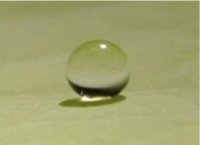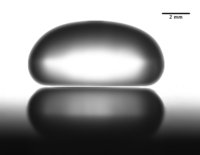Super-hydrophobicity
[
 Once placed on a lotus leaf, a water drop looks like a pearl, whereas it spreads on glass. Why?
Once placed on a lotus leaf, a water drop looks like a pearl, whereas it spreads on glass. Why?
First, there is a chemical effect: glass, unlike the vegetal wax that coats lotus leaves, has a strong affinity for water. This is why a water drop spreads more easily on clear glass than on greasy glass. Then, there is an additional physical effect: the surface of the lotus leaf is covered with many microscopic bumps. The droplet does not touch the bottom of this rough surface: it sits on the top of those micro-bumps like a fakir on nails.
We can mimic lotus leaf in our laboratory designing forests of micro-pillars by micro-fabrication techniques. Such substrates allow us to study the stability of those « fakir drops » and their subsequent properties: bouncing droplets, anti-adhesion, low-friction, anti-fogging…/]

Leidenfrost effect
When a water droplet meets a hot surface, it starts to boil and turns into vapor very quickly. But when the surface is clearly above the boiling temperature, the vapor forms quickly enough to create a thin layer between the surface and the drop, which is therefore levitating This vapor film has two roles: 1) it isolates the drop from the substrate; the drop does not boil and lasts for several minutes. 2) like on a lotus leaf, the liquid gets a very rounded shape and does not stick to the surface, which gives it an extreme mobility. This state is called calefaction (this is also sometimes called Leidenfrost effect).
We are interested in the description of this effect and especially the control of the movement of the drop. We also looking at other techniques to produce similar levitation: by blowing air or moving the substrate…
Washing wedges

How can oil be extracted from a confined region? We present an experiment where oil is first trapped in a wedge is spontaneously washed away by a more wetting liquid (a surfactant solution) through a capillary instability. Regular fingers progressively grow and droplets pinch off. They are eventually driven away from the apex of the wedge by surface tension.
Watch the full movie.
- L. Keiser, R. Herbaut, J. Bico & E. Reyssat, "Washing wedges: capillary instability in a gradient of confinement", J.Fluid Mech., 790, 619-633 (2016)


